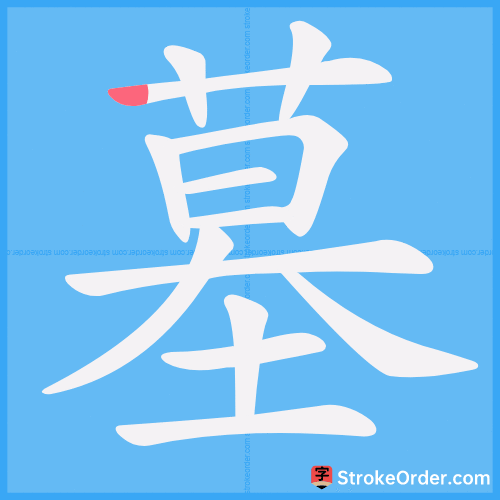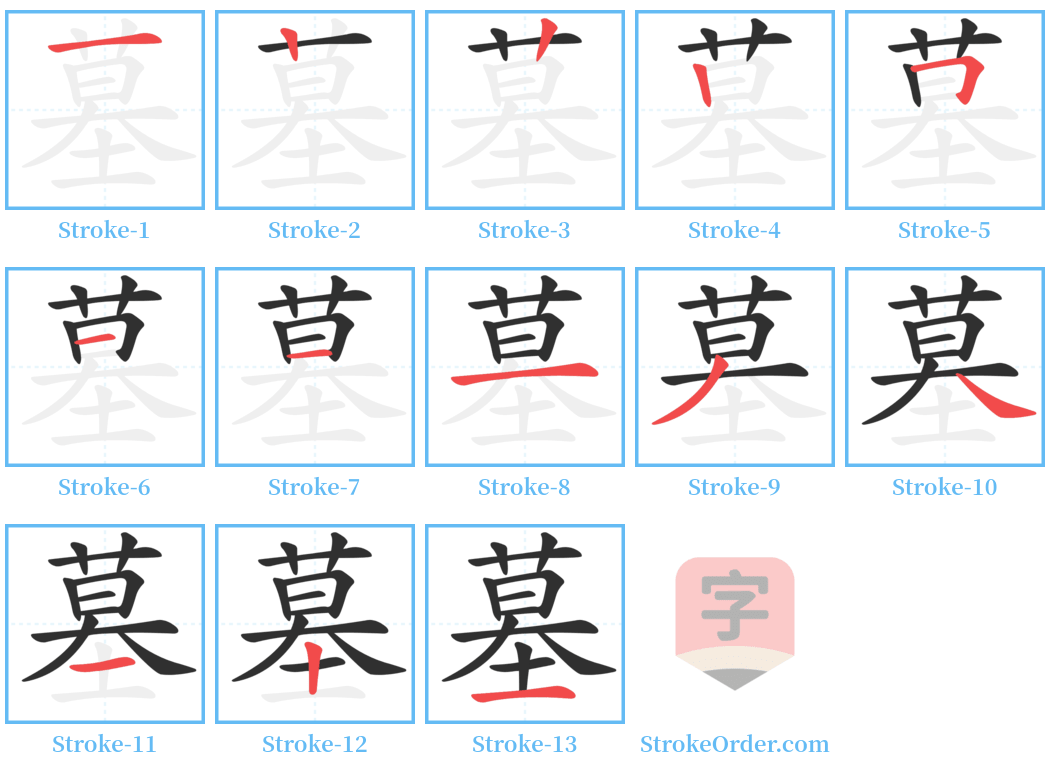墓 Stroke Order
Animated Stroke Order of 墓

Stroke Order Diagrams for 墓

Step-by-Step Handwriting Guide for 墓

Learn to Write Chinese Characters with Video Tutorials
Watch the video of writing the Chinese character "墓", learn the correct stroke order (笔顺) of the character "墓", and master the standard way of writing the character "墓".
Free Printable Handwriting Practice with Stroke Order: 墓
Printable Writing Practice Worksheet of "墓" in Portrait Orientation (Tian Zi Ge)

Printable Writing Practice Worksheet of "墓" in Landscape Orientation (Tian Zi Ge)

Information of 墓
Pinyin
mù
Radical
土
Strokes
13 strokes
Usage
★★★★★
Definition
tomb
墓 [mù]
名
1. 埋葬死人的地方。
[En.] A place to bury the dead.
2. 埋葬死人的地方:~穴 (grave hole), ~地 (grave site), ~园 (graveyard), ~道 (grave path), ~碑 (tombstone), 坟~ (grave). ~志铭 (epitaph).
[En.] A place to bury the dead: grave hole, grave site, graveyard, grave path, tombstone, grave. Epitaph.
3. 同本义。后不加区别,统称作墓。
[En.] The same as the original meaning. Later, it is generally referred to as a grave or tomb.
4. 墓地。
[En.] Graveyard.
5. 墓志。
[En.] Grave marker.
6. 宏伟的陵墓。
[En.] Mausoleum.
动
1. 葬。
[En.] Bury.
引
1. 《说文》:墓,丘也。
[En.] "Shuōwén": A grave is also a mound.
2. 《广雅》:墓,冢也。
[En.] "Guǎngyǎ": A grave is also a tomb.
3. 《论衡·讥日》:墓,土也。
[En.] "Lùn Héng": A grave is earth.
4. 冢茔之地。——《周礼·墓大夫》注
[En.] The tomb area. — "Zhōulǐ: Notes on the Tomb Minister."
5. 《礼记·曲礼》:适墓不登垄。
[En.] "Lǐjì": If going to the grave, do not step on the ridge.
6. 《礼记·檀弓》:古也墓而不坟。注:“墓谓兆域,今之封茔也。”
[En.] "Lǐjì": In ancient times, there were graves but not tombs. Note: "Grave refers to burial areas, which are now known as tombs."
7. 《古诗十九首》:古墓犁为田,松柏摧为薪。
[En.] "Nineteen Ancient Poems": Old graves plowed into fields, cedar and cypress cut down for firewood.
8. 《礼记·檀弓上》:古也墓而不坟。
[En.] "Lǐjì": In ancient times, there were graves but not tombs.
9. 张溥《五人墓碑记》:且立石于墓之门,以旌其所为。
[En.] "Zhang Pu's 'Memorial for Five People': Set up a stone at the entrance of the grave to inform of their deeds."
例
1. 又如: 墓庐 (房屋旁边的墓); 墓隧 (墓前的甬道); 墓堂 (坟墓前的祭堂); 墓庭 (坟墓周围的庭院)。
[En.] For example: Tomb lodgings (houses next to graves); grave tunnels (pathways in front of graves); tomb halls (ceremonial halls in front of graves); tomb courtyards (courtyards around graves).
2. 墓厉 (茔地周围界域的标志); 墓工 (以看风水择墓地为职业的人); 墓邻 (相邻墓地的墓主); 墓亭 (墓地上的碑亭)。
[En.] Grave boundaries (markers around grave areas); grave workers (those who choose burial sites based on geomancy); grave neighbors (owners of adjacent graves); grave pavilions (pavilions on cemetery grounds).
3. 墓石 (墓志; 墓碑); 墓文 (墓志); 墓铭 (刻在石上埋入坟中的文字); 墓刻 (指墓碑上的刻文)。
[En.] Grave stones (grave markers); grave writings; epitaphs (inscriptions on stones buried in graves); grave engravings (inscriptions on tombstones).
4. 宏伟的陵墓。
[En.] Magnificent mausoleums.
例
如: 烈士墓; 墓阙 (陵墓前的石建筑,通常左右各一)。
[En.] For example: Martyrs' tomb; grave pylon (stone structures on either side of tombs).
Input Method for 墓
Pinyin
mu4
Wubi
ajdf
Cangjie
takg
Zhengma
ekgb
Four Corner
44104
Unicode
U+5893
Same Pronunciation Characters